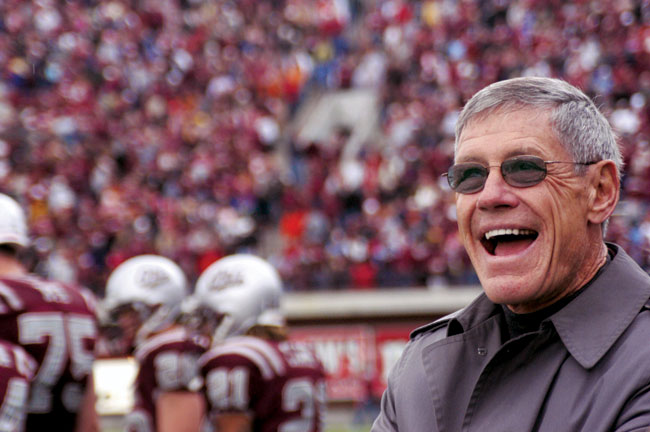THE UNIVERSITY OF MONTANA
2009 PRESIDENT'S REPORT
|
| President George M. Dennison enjoys another Griz victory in Washington-Grizzly Stadium on Oct. 20, 2007. Dennison often roamed the sidelines, and the football team was 212-55 during his tenure. On this particular day, the Griz defeated Northern Colorado 52-7. |
From the President's Desk:
This issue of the President’s Report offers the occasion to reflect on my experience during 20 years in the presidency. The details of some of the physical development appear in the pages that follow, along with a few comments about program development. Quite clearly, the face of campus has changed markedly – far more than I ever anticipated when I arrived in August 1990. During the past two decades, the usable space increased by roughly 1.3 million square feet – nearly one-quarter of the total space on campus today. These changes occurred because of the needs and aspirations of the campus community.
The demography of the campus changed as well, with the student population growing from roughly 10,000 to nearly 15,000, and the faculty numbers nearly doubling from 380 in 1990 to 663 in 2010. The faculty today has a heavier commitment to research and graduate education than 20 years ago, with the annual volume of externally funded research going from less than $7 million in 1990 to nearly $70 million in 2010 and the awarded doctorates increasing from about 15 to 75 annually. However, I think it even more revealing to note that the University has graduated more alumni, counting all degrees, in these 20 years than during the preceding century.
During these years of growth and change, the concern has focused on financing, for operations as well as facilities and infrastructure. Operationally, the budget for the academic programs alone grew from about $40 million in 1990 to some $140 million in 2010 in a total budget of $370 million. Over those same years, tuition revenue became the dominant source of support for academic programs, rising in percentage terms from about 25 to nearly 65 percent. Everyone who reads the press knows that tuition has risen faster than the rate of inflation, but few people know that state support lagged the inflation rate and enrollment growth. To fill the gap and sustain the quality of the programs, as well as access to them for all qualified applicants, students and their families assumed the burden of rising tuition and friends and alumni stepped forward to assist with donated funds. During those 20 years, generous donors provided in excess of $500 million for scholarships, fellowships, professorships, program endowments and facilities. An emergent and maturing culture of philanthropy goes far to explain the remarkable progression of the University into the 21st century.
It seems clear that if the past is prologue, concern about finances will persist through the next decade and beyond. That becomes even more apparent when we consider that during the next decade, the United States will seek to reclaim world leadership defined by the educational attainment of its citizenry – a position lost during the last two decades. The human resource economy of today simply demands an educated work force as the sine qua non for any country wishing to compete in an increasingly global world. As Dr. Craig Barrett, former CEO of Intel, reminded us in his Commencement address in 2009, “You cannot win unless you choose to compete.” I think The University of Montana well positioned to assist the people of Montana in their choice to compete.
Having invested so much in the life of the University, I trust that what we have achieved together will prove resilient. Every administrator seeks to institutionalize changes that will make the difference over time. While only time will tell, I firmly believe that we have prepared well for the future. I will close by expressing my deep gratitude and appreciation for your interest and assistance over these years, as well as your willingness to overlook and understand any errors of judgment I made along the way. This University has the blessing of a wonderful group of friends and alumni ready to help in any way to assure its continued maturation and development as a center of learning committed to serving the public interest.
George M. Dennison
President and Professor of History
1990-2010
contents|um home
The University of Montana-Missoula
32 Campus Drive | Missoula, MT 59812
phone 406-243-2522 | fax 406-243-4520
© 2008 The University of Montana

